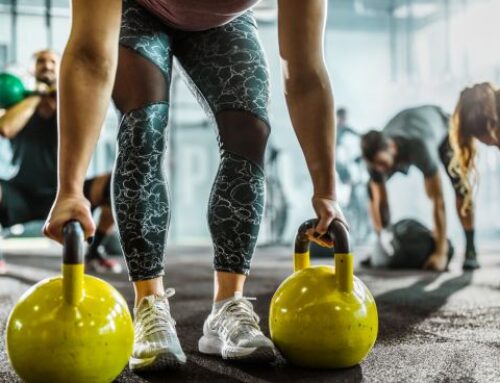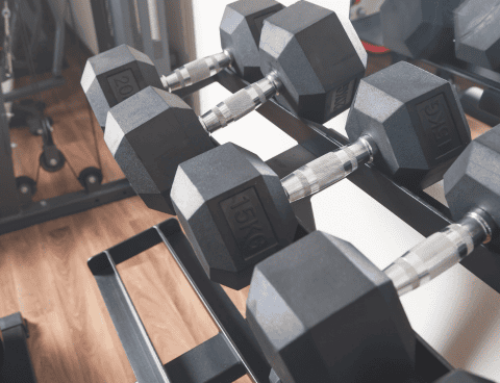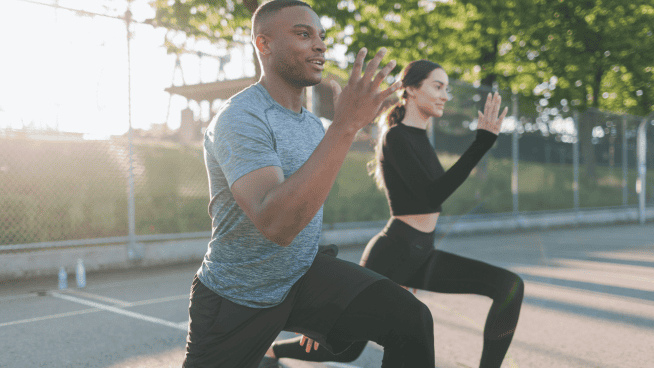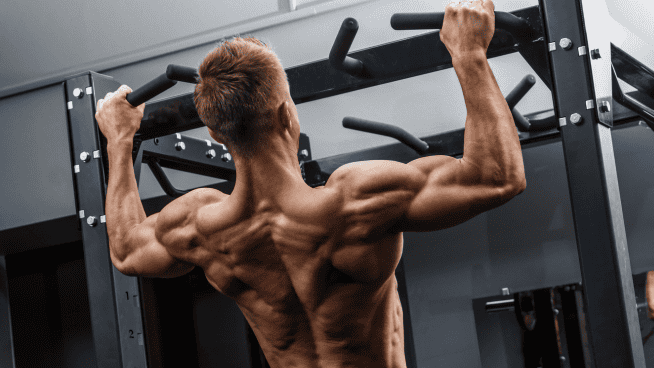5 Ways Everyone Screws Up Barbell Rows
The Barbell Row, or Barbell Bent-Over Row, is a strength exercise that works the back muscles. It’s a challenging lift to perform, but it’s one of the most effective exercises for building back strength and size if done correctly.
In this article, we cover everything you need to know about the Barbell Row to build a stronger back and perform the exercise pain-free.
Barbell Row Form
Step 1: Stand with your feet hip-width apart and the barbell positioned over your feet. Bend down and grasp the bar with a shoulder-width overhand grip. Assume a deadlift position with your back flat and shoulders pulled down and back. With your arms straight, deadlift the bar up so the plates are about an inch above the ground.
Note: To use this form, you will need to use 45-pound plates or bumper plates. If neither one is available, begin with the bar on a rack.

Step 2: Keeping your core tight and back flat, pull your shoulders back to initiate the row and drive your elbows back. The bar should touch or almost touch your body under your chest. It’s OK to use a slight rock to initiate the movement (more on this later).

Step 3: Lower the bar with control until your arm are straight and return to the starting position. Continue to keep your core tight and back flat.
Barbell Row Mistakes
Several common mistakes can quickly turn this potent back-building exercise into an injury waiting to happen. Here are the key mistakes you need to avoid.
Bouncing
This is the No. 1 no-no for the Barbell Bent-Over Row and it’s probably the most common mistake. It’s typically the result of using a weight that’s too heavy, forcing you to bounce up and down to generate enough momentum to move the load. This is cheating, plain and simple.
The Fix: Use a lighter weight. Performing the exercise with a weight you can control will more effectively recruit your back muscles and give you the intended benefit of the exercise. Bouncing up and down lets momentum do all the work.
That said, a small bounce can actually improve the lift. Strength coach Lee Boyce explains that your biceps are often the limiting factor, and a small bounce helps overcome this weakness, allowing you to lift a weight that challenges your back muscles. He details this technique in the video below:
To reiterate, this is a small bounce, not a spastic up-and-down movement.
Standing Upright
If your torso is at a 45-degree angle (or more), you’re doing it wrong. This is usually due to a lack of core strength or, again, using a weight that’s too heavy. The exercise ends up looking more like a bad version of a Yates Row, a variation that uses an underhand grip to hit the upper back.
The Fix: Your first solution is to develop a stronger core. Our 27 Best Core Exercises is a great place to start. If core strength isn’t an issue, try placing a plate on your lower back to teach yourself the proper position, as Dr. Joel Seedman demonstrates in the video below. Start with a light plate—Seedman is using two plates but is quite strong and has perfect technique.
Flaring Your Elbows
Flaring your elbows shifts the bar forward and in front of your midfoot, which increases the amount of stress on your lower back. Also, a flared position is more likely to cause shoulder pain; however, this varies from person to person.
The Fix: Row the bar in a vertical line over your midfoot to just below your chest and make sure your elbows are at about a 45-degree angle with your body.
Rounding Your Back
Rounding your back places your spine in a dangerous position that increases your risk of an injury—a reason many people avoid this exercise in the first place.
The Fix: Brace your abs as if you’re about to take a punch with your back in a neutral position, which you can learn how to find here. Use a lighter weight if you can’t maintain this position.
Poor Neck Position
Believe it or not, neck position matters. Looking too far up or down can throw the rest of your spine out of whack, making it difficult to hold a safe and stable torso position as you row heavy weight.
The Fix: Align your neck so it’s in a straight line with your back. The easiest way to find this position is to focus your eyes on the ground a few feet in front of your body and give yourself a double chin.
Benefits of Barbell Rows
The Barbell Row is a compound pulling exercise that strengthens the back muscles, but it can be considered a full-body exercise. Your middle- and upper-back muscles along with your biceps initiate the pulling movement. However, your core—especially your lower back, glutes and hamstrings—play a critical role in maintaining the challenging bent-over position.
Beyond developing a stronger and bigger back, the move is a great tool for improving strength and form for the Squat, Bench Press and especially the Deadlift, since the upper back is often a limiting factor on these exercises. In the case of the Deadlift, Barbell Rows build the back strength needed to prevent a rounded spine as you begin to lift heavier weight loads.
Barbell Row Muscles Worked
The Barbell Row primarily develops the pulling muscles of the back, which include the latissimus dorsi, trapezius, rhomboids, posterior deltoids and other small muscles that act on the shoulder blades and shoulder joint. The lower-back muscles and biceps also play important roles in the exercise.

Barbell Row Alternatives and Variations
There are many variations of the Barbell Row that provide a slightly different challenge for your back.
Pendlay Row
Pendlay Rows are similar to Barbell Rows, but a brief pause is added with the plates on the floor. You need 45-pound plates or bumper plates to do this variation, which reinforces proper rowing form and is a great strength builder.
Chest-Supported Row
Dr. John Rusin advises avoiding Barbell Rows altogether and performing the Chest-Supported Row. The chest-supported position allows you to isolate your back without placing undue stress on your spine.
T-Bar Row
The T-Bar Row allows for a more upright position, which places less stress on your back and allows you to lift heavier loads.
Inverted Row
The Inverted Row offers many of the back strength benefits of the Bent-Over Row in a position that’s far easier to maintain, making this an ideal option for beginners.
Barbell Row Workouts
Here are a few workout options that feature Barbell Rows:
Barbell Row-Only Workout
1) Barbell Rows – 5×5
Barbell Row Superset
Perform these back-to-back in a superset with no rest between moves.
1a) Barbell Rows – 4×8
1b) Dumbbell Bench Press – 4×8
Upper-Body Workout With Barbell Rows
1) Bench Press – 5×3
2) Barbell Rows – 5×5
3) Hex Press – 4×10
4) Pull-Ups – 4×8-10
5) Skull Crushers – 3×12
6) Hammer Curls – 3×15
RELATED:
RECOMMENDED FOR YOU
MOST POPULAR
5 Ways Everyone Screws Up Barbell Rows
The Barbell Row, or Barbell Bent-Over Row, is a strength exercise that works the back muscles. It’s a challenging lift to perform, but it’s one of the most effective exercises for building back strength and size if done correctly.
In this article, we cover everything you need to know about the Barbell Row to build a stronger back and perform the exercise pain-free.
Barbell Row Form
Step 1: Stand with your feet hip-width apart and the barbell positioned over your feet. Bend down and grasp the bar with a shoulder-width overhand grip. Assume a deadlift position with your back flat and shoulders pulled down and back. With your arms straight, deadlift the bar up so the plates are about an inch above the ground.
Note: To use this form, you will need to use 45-pound plates or bumper plates. If neither one is available, begin with the bar on a rack.

Step 2: Keeping your core tight and back flat, pull your shoulders back to initiate the row and drive your elbows back. The bar should touch or almost touch your body under your chest. It’s OK to use a slight rock to initiate the movement (more on this later).

Step 3: Lower the bar with control until your arm are straight and return to the starting position. Continue to keep your core tight and back flat.
Barbell Row Mistakes
Several common mistakes can quickly turn this potent back-building exercise into an injury waiting to happen. Here are the key mistakes you need to avoid.
Bouncing
This is the No. 1 no-no for the Barbell Bent-Over Row and it’s probably the most common mistake. It’s typically the result of using a weight that’s too heavy, forcing you to bounce up and down to generate enough momentum to move the load. This is cheating, plain and simple.
The Fix: Use a lighter weight. Performing the exercise with a weight you can control will more effectively recruit your back muscles and give you the intended benefit of the exercise. Bouncing up and down lets momentum do all the work.
That said, a small bounce can actually improve the lift. Strength coach Lee Boyce explains that your biceps are often the limiting factor, and a small bounce helps overcome this weakness, allowing you to lift a weight that challenges your back muscles. He details this technique in the video below:
To reiterate, this is a small bounce, not a spastic up-and-down movement.
Standing Upright
If your torso is at a 45-degree angle (or more), you’re doing it wrong. This is usually due to a lack of core strength or, again, using a weight that’s too heavy. The exercise ends up looking more like a bad version of a Yates Row, a variation that uses an underhand grip to hit the upper back.
The Fix: Your first solution is to develop a stronger core. Our 27 Best Core Exercises is a great place to start. If core strength isn’t an issue, try placing a plate on your lower back to teach yourself the proper position, as Dr. Joel Seedman demonstrates in the video below. Start with a light plate—Seedman is using two plates but is quite strong and has perfect technique.
Flaring Your Elbows
Flaring your elbows shifts the bar forward and in front of your midfoot, which increases the amount of stress on your lower back. Also, a flared position is more likely to cause shoulder pain; however, this varies from person to person.
The Fix: Row the bar in a vertical line over your midfoot to just below your chest and make sure your elbows are at about a 45-degree angle with your body.
Rounding Your Back
Rounding your back places your spine in a dangerous position that increases your risk of an injury—a reason many people avoid this exercise in the first place.
The Fix: Brace your abs as if you’re about to take a punch with your back in a neutral position, which you can learn how to find here. Use a lighter weight if you can’t maintain this position.
Poor Neck Position
Believe it or not, neck position matters. Looking too far up or down can throw the rest of your spine out of whack, making it difficult to hold a safe and stable torso position as you row heavy weight.
The Fix: Align your neck so it’s in a straight line with your back. The easiest way to find this position is to focus your eyes on the ground a few feet in front of your body and give yourself a double chin.
Benefits of Barbell Rows
The Barbell Row is a compound pulling exercise that strengthens the back muscles, but it can be considered a full-body exercise. Your middle- and upper-back muscles along with your biceps initiate the pulling movement. However, your core—especially your lower back, glutes and hamstrings—play a critical role in maintaining the challenging bent-over position.
Beyond developing a stronger and bigger back, the move is a great tool for improving strength and form for the Squat, Bench Press and especially the Deadlift, since the upper back is often a limiting factor on these exercises. In the case of the Deadlift, Barbell Rows build the back strength needed to prevent a rounded spine as you begin to lift heavier weight loads.
Barbell Row Muscles Worked
The Barbell Row primarily develops the pulling muscles of the back, which include the latissimus dorsi, trapezius, rhomboids, posterior deltoids and other small muscles that act on the shoulder blades and shoulder joint. The lower-back muscles and biceps also play important roles in the exercise.

Barbell Row Alternatives and Variations
There are many variations of the Barbell Row that provide a slightly different challenge for your back.
Pendlay Row
Pendlay Rows are similar to Barbell Rows, but a brief pause is added with the plates on the floor. You need 45-pound plates or bumper plates to do this variation, which reinforces proper rowing form and is a great strength builder.
Chest-Supported Row
Dr. John Rusin advises avoiding Barbell Rows altogether and performing the Chest-Supported Row. The chest-supported position allows you to isolate your back without placing undue stress on your spine.
T-Bar Row
The T-Bar Row allows for a more upright position, which places less stress on your back and allows you to lift heavier loads.
Inverted Row
The Inverted Row offers many of the back strength benefits of the Bent-Over Row in a position that’s far easier to maintain, making this an ideal option for beginners.
Barbell Row Workouts
Here are a few workout options that feature Barbell Rows:
Barbell Row-Only Workout
1) Barbell Rows – 5×5
Barbell Row Superset
Perform these back-to-back in a superset with no rest between moves.
1a) Barbell Rows – 4×8
1b) Dumbbell Bench Press – 4×8
Upper-Body Workout With Barbell Rows
1) Bench Press – 5×3
2) Barbell Rows – 5×5
3) Hex Press – 4×10
4) Pull-Ups – 4×8-10
5) Skull Crushers – 3×12
6) Hammer Curls – 3×15
RELATED:














